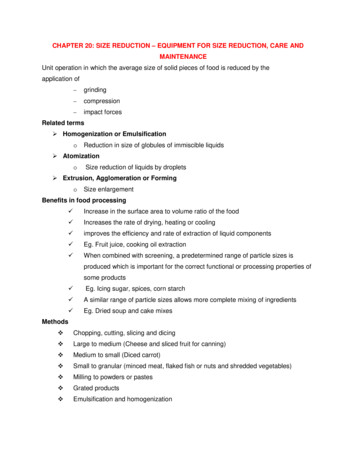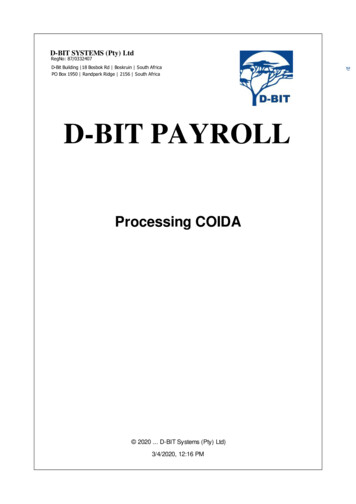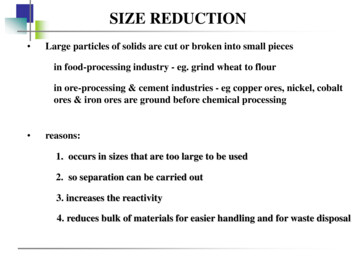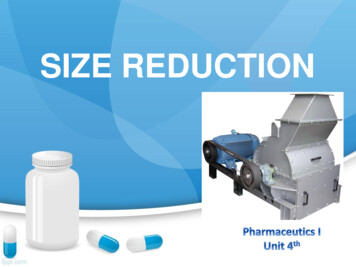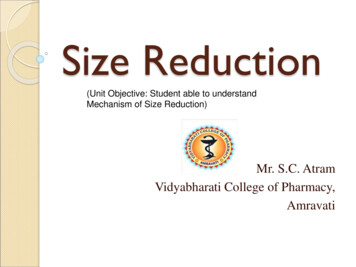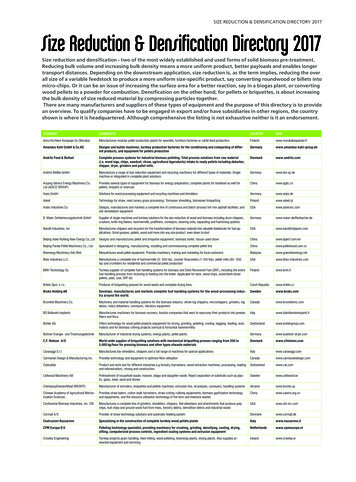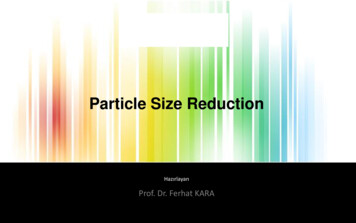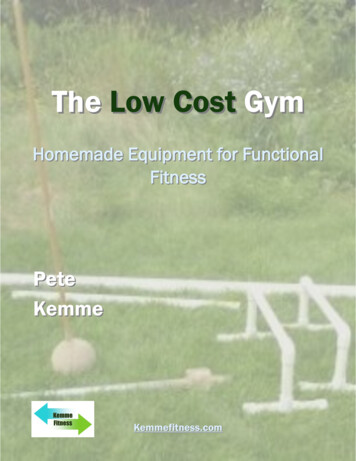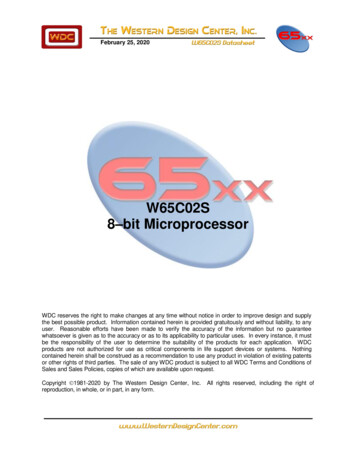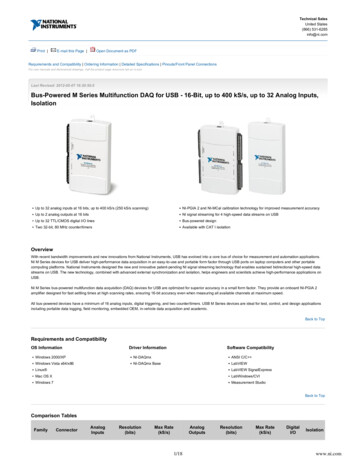
Transcription
SIZE REDUCTION
APPLICATIONS To obtain workable size To obtain powders Obtain specific shape and size Increase reactivity Permit separation of unwanted ingredient Mineral, Metallurgical Industries, Pharmaceutical Industry, FoodIndustry, Nanotechnology,
MECHANISM OF SIZE REDUCTION COMPRESSIONIMPACTATTRITIONSHEARNon-mechanical introduction of energy (Thermalshock, explosive shattering, electrohydraulic) (a) Between two solid - crushing or attrition; (b)shearing; (c) Compression crushing in a particle bed (d)Impact at one solid surface (e) Impact between particles (f) Shear action of the surrounding medium
ENERGY & POWER REQUIREMENT IN SIZE REDUCTIONWhen stress is applied, material are distorted and strained. Work necessary to strain is stored as mechanical energy till the ultimate strength isreached Breaks up into pieces – increase in surface area Energy goes to increase in surface area, and excess energy is liberated as heat𝑠𝑢𝑟𝑓𝑎𝑐𝑒 𝑒𝑛𝑒𝑟𝑔𝑦 𝑐𝑟𝑒𝑎𝑡𝑒𝑑 𝑏𝑦 𝑖𝑛𝑔 𝐸𝑓𝑓𝑖𝑐𝑖𝑒𝑛𝑐𝑦, η𝑐 𝑒𝑛𝑒𝑟𝑔𝑦 𝑎𝑏𝑠𝑜𝑟𝑏𝑒𝑑 𝑏𝑦 𝑡ℎ𝑒 𝑚𝑎𝑡𝑒𝑟𝑖𝑎𝑙𝑒𝑠 𝐴𝑤 𝑝 𝐴𝑤 𝑓η𝑐 𝑊𝑠es Surface energy per unit area, J/m2Aw specific surface area, Suffix p product, f feed., m2/kgWs energy absorbed by unit mass of solid.J/kg𝑒𝑛𝑒𝑟𝑔𝑦 𝑎𝑏𝑠𝑜𝑟𝑏𝑒𝑑 𝑏𝑦 ��ℎ𝑎𝑛𝑖𝑐𝑎𝑙 𝐸𝑓𝑓𝑖𝑐𝑖𝑒𝑛𝑐𝑦, η𝑚 𝑒𝑛𝑒𝑟𝑔𝑦 𝑖𝑛𝑝𝑢𝑡 𝑡𝑜 𝑡ℎ𝑒 𝑚𝑎𝑐ℎ𝑖𝑛𝑒𝑊𝑒𝑠 𝐴𝑤 𝑝 𝐴𝑤 𝑓𝑊𝑠𝑊 η𝑚η𝑚 η𝑐POWER REQUREMENT:𝑃 𝑊𝑚 𝑒𝑠 𝐴𝑤 𝑝 𝐴𝑤 𝑓 𝑚η𝑚 η𝑐
POWER REQUIREMENT IN SIZEREDUCTION𝑃 𝑊𝑚 𝐷𝑠 𝑒𝑠 𝐴𝑤 𝑝 𝐴𝑤 𝑓 𝑚6𝜑𝑠 𝜌𝑝 𝐴𝑤η𝑚 η𝑐or𝐴𝑤 6𝜑𝑠 𝜌𝑝 𝐷𝑠6𝑒𝑠 𝑚11𝑃 η𝑚 η𝑐 𝜌𝑝 𝜑𝑠𝑝 𝐷𝑠𝑝 𝜑𝑠𝑓 𝐷𝑠𝑓
RITTINGERS LAW [1867] The work required for size reduction is proportional to thenew surface area created:𝑃𝑊𝑅 𝐴𝑤 𝑝 𝐴𝑤 𝑓𝑚𝑃11𝑊𝑅 𝑚𝜑𝑠𝑝 𝜌𝑝𝑝 𝐷𝑠𝑝 𝜑𝑠 𝜌𝑝𝑓 𝐷𝑠𝑓𝑃111𝑊𝑅 𝑚 𝜑𝑠 𝜌𝑝 𝐷𝑠𝑝 𝐷𝑠𝑓𝑃11𝑊𝑅 𝐾𝑅 𝑚𝐷𝑠𝑝 𝐷𝑠𝑓 Where KR is called the Rittinger’s Constant. Application of the law Where surface area created is significant – fine grinding Particle size less than 0.05mm Energy in put is not very high
Kicks Law (1885)The work required for crushing a given mass of material isconstant for a given reduction ratio irrespective of the initial size.Reduction ratio is the ratio of the initial particle size to finalparticle size.𝑃𝑊𝐾 𝑐𝑜𝑛𝑠𝑡𝑎𝑛𝑡 𝑥 𝑟𝑒𝑑𝑢𝑐𝑡𝑖𝑜𝑛 𝑟𝑎𝑡𝑖𝑜𝑚𝐷𝑠𝑓𝑃𝑊𝐾 𝐾𝐾 𝑙𝑛𝑚𝐷𝑠𝑝 KK is called the Kick’s Constant Kicks law is application based on stress analysis if plastic deformation within the elastic limit. More accurate than Rittingers law for course crushing. Applicable for feed size greater than 50mm
Bond’s Law (1952)The work required to form particles of size Dp p from a very large particle sizeis proportional to the square root of the surface to volume ratio (𝑠𝑝 𝑣𝑝 ) ofthe product.𝑠𝑝66𝜑𝑠 ,𝑂𝑅 𝑠𝑝 𝜑𝐷𝑝𝑣𝑝 𝜑𝐷𝑝𝑠𝑝𝑃𝑊𝐵 𝑚𝑣𝑝 𝑝𝑊𝐵 𝑃61 𝐾 𝐾𝐵𝑚𝜑𝐷𝑝𝑝𝐷𝑝𝑝 Where , 𝐾𝐵 Bonds constantEnergy required to reduce from Dpf to Dpp𝑃𝑊𝐵 𝐾𝐵𝑚 If feed is very large, 𝑊𝐵 𝑃𝑚 𝐾𝐵1𝐷𝑝𝑝1𝐷𝑝𝑝 1𝐷𝑝𝑓
WORK INDEX Work Index, Wi, is the gross energy requirement in kilowatthour per ton of feed (kWh/ton of feed) to reduce a very largeparticle to such a size that 80% of the product will pass througha 10micrometer, or 0.1 mm screen. If Dp is in mm, 𝑊𝑖 𝐾𝐵1𝐷𝑝𝑝𝐾𝐵 0.1𝑊𝑖 0.3162𝑊𝑖𝑃11 0.3162𝑊𝑖 𝑚𝐷𝑝𝑓𝐷𝑝𝑝 Values of WI for wet Grinding:PropertySoftWork Index,𝑊𝑖 , KWh/ton 7-9MediumHardVery hard9-1414-20 20
Assumption in the theories/empiricalequations of size reduction Energy W, required to produce a change dDp in a particle of size Dp isa power function of size Dp𝑑𝑊𝐶 𝑛𝑑𝐷𝑝𝐷𝑝 For Rittinger’s law n 2 Kick’s Law n 1 Bonds law n 1.5
Particles of average feed size 50 x 10(-4) m are crushed to an averageproduct size of 10 x 10 (-4) m at the rate of 20 tonnes per hour. At this rate,the crusher consumes 40 kW of power of which 5 kW are required forrunning the mill empty. Calculate the power consumption if 12 tonnes/h ofthis product is further crushed to 5 x 10 (-4) m size in the same mill?Assume that Rittinger’s law is applicable. It is desired to crush 10 ton/hr of iron ore hematite. The size of the feed issuch that 80% passes a 72.6 mm screen, and 80% of product a 3.175mmscreen. Calculate the gross power requirement for wet grinding and drygrinding. Work index of Hematite is 12.68 [Ans 17.96kW]
Size Reduction EquipmentA. Crushers (Coarse and Fine)1.2.3.Jaw CrusherGyratory CrusherCrushing RollsB. Grinders (Intermediate and Fine)1.2.Hammer MillsRolling Compression Millsa.b.3.4.Bowl MillsRoller MillsAttrition MillsTumbling Millsa.b.c.Rod MillsBall Mill; Pebble MillTube Mills; Compartment Mills A primary crusher operates on run of mine materialaccepting anything that comes from the mine face andbreaking into 150-250 mm (6-10 in). A Secondary crusher reduces these lumps into 6 mm(1/4 in). Grinders reduce crushed feed to powders The product from a intermediate grinder might pass a40-mesh screen Most of the product from a fine grinder would pass a200 mesh screen with 74 micron opening.
Size Reduction EquipmentC. Ultrafine Grinders1. Hammer Mills with internal classification Feed Size is less than 6mm.2. Fluid Energy Mills Product size is 1-50 microns3. Agitated MillsD. Cutting Machines1. Knife Cutters; dicers; millers. Definite size and shape Product size will be 2-10 mmin length.
Breaking Pattern There are different mechanisms by which size reduction may beachieved. Impact:Particle breaks by a single rigid force Compression: Particle disintegration by two rigid forces Shear:Produced when the particle is compressed between 2edges of the hard surfaces Attrition:Arising form particles scrapping between 2 surfaces.
Crushers: Blake Jaw Crusher‘V’ Opening at the topReciprocating in a horizontal PlaneAngle 20-30
Crushers: Jaw Crusher Eccentric Motion
Crushers: Jaw Crusher The jaw open and close 250-400 times perminute. Mechanism: Compression Eccentric drives a pitman which is connectedto two toggles among which one is connectedto frame another to moving jaw. The greatest motion is at the bottom of ‘V’which means there is little tendency to choke. Feed size 1.8m (6ft) in diameter. Product Size: 250 mm (10in) Capacity: 1200 ton/hr
Crushers : Types of Jaw CrusherSingle Toggle – An eccentric shaft positioned atthe top of the crusher.Double toggle – Two shafts – first pivoted at thetop of the crusher where as other is an eccentricshaft which drives the both the toggles. Eccentric positioned behind the swinging jaw.It has two effects.1. It keeps the eccentric out of harm.2. The other effect is limited motion forswinging jaw, which reduces theproductivity of the jaw. In contrast, the single toggle jaw crusher has fewer shafts. It has two motions simultaneously:swinging motion that double toggle has and up and down motion from the eccentric. Single toggle crusher has better capacity compared to a double toggle crusher.
Crushers : Portable Jaw Crusher
Crushers : Gyratory Crusher Mechanism : Compression A gyratory crusher may be looked up on as a jawcrusher with circular jaws, between which materialis being crushed at some point all the time. A conical crushing head gyrates inside a funnelshaped casing open at the top. A crushing head is pivoted at the top. An eccentric drives the bottom end of the shaft. The bottom of the crushing head move towards andaway from the wall. Solid caught in the V-shaped space between thehead and casing are broken and re-broken until theypass out the bottom.
Crushers : Gyratory Crusher Speed of gyratory is 125-425 gyratory per minute. Because some part of the working head is working all thetime the discharge from the gyratory is continuous insteadof intermittent as jaw crusher. Less maintenance and power requirement is smallcompared with jaw crusher. And the capacity is more than jaw crusher 4500 ton/hr. The capacity varies with1. Jaw setting2. The impact strength of the feed.3. Speed of the gyratory machine.
Crushers : Gyratory Crusher
Crushers : Smooth Roll Crushers Heavy smooth faced metal rolls turning onparallel horizontal are working elements ofsmooth roll crusher. Particles of feed caught between the rolls arebroken in compression and drop out below. The rolls turn towards each other at the samespeed. They have relatively narrow faces (300-917mm)and large diameter (600-1200mm) so that theycan ‘nip’ the large lumps. Rolls speed 50-300 rpm. These are consider as secondary crushers with The product size can be estimated asDp 0.04R dfeeds 12-75 mm in size and the product is 12-1Where R Radius of the rollmm.d half the width of the gap between the rolls.
Crushers : Smooth Roll Crushers The maximum size of the product is 2d. These operates most effectively when set to give a reductionratio of 3 or 4 or 1. That is the max diameter of the particle is 1/3rd or 1/4th ofthat feed. The forces exerted by these rolls are very great from 8700 –70000 N/cm. To allow unbreakable material to pass through withoutdamaging the machine, at least one roll must be springmounted.
Crushers : Smooth Roll Crushers
Crushers : Smooth Roll CrushersFTFTFRFRFNFN2α
Crushers : Toothed Roll Crushers Roll faces carry corrugations, breaker bars, or teeth. Contains 2 rolls as in smooth roll crusher or one rollacting against stationary curved breaker plate. Machine shown in a figure is single roll toothed crusher. Machines known as disintegrators contain two corrugatedrolls turning at two different speeds which tear the feedapart.Double Tooth CrusherSingle Tooth CrusherPyramid Tooth
Crushers : Toothed Roll Crushers Toothed roll crushers are much more versatile then smooth rollcrusher, within the limitation that they cannot handle very hard solids. Operated by compression, impact and shear. The particle size feed to these machines may be given as great as 500mm and the capacity is 500tons/hr.
Crushers : Toothed Roll Crushers
Breaking Pattern of the CrushersCrusherCompressionJaw CrusherYGyratory CrusherYSmooth Roll CrusherYTooth Roll CrusherYImpactYAttritionShearY
ComparisonCrusherFeed SizeProduct SizeCapacity(ton/hr)PowerRequirementJaw Crusher1.8 m250 mm1200HighGyratory CrusherSameSame4500High12-75 mm12-1 mm350Low500 mmSame500LowSmooth Roll CrusherTooth Roll Crusher
Grinders The product from a crusher is often fed to grinder in which it is reduced topowder.Grinders (Intermediate and Fine)1. Hammer Mills2. Rolling Compression Millsa.b.Bowl MillsRoller Mills3. Attrition Mills4. Tumbling Millsa.b.c.Rod MillsBall Mill; Pebble MillTube Mills; Compartment Mills
Grinders: Hammer MillFeedIntroducing Contains high speed rotor. Feed dropped into the top of casing is broken and fallout through the bottom opening. Particles are broken by sets of swing hammer pinned toa rotor disk. Particle enter into the casing can not escape beingstruck by the hammers. It shatters into pieces, which fly against stationary anvilplate and break into small pieces. These in turn rubbed into powder by hammers andpushed through the grate or screen that covers thedischarge opening.ProductDischarge
Grinders: Hammer Mill Several rotary disks 150-450 mm in diameter contains andeach having 4 to 8 hammers mounted on the same shaft. The hammers may be straight bars of metals with plain orenlarged ends or with ends sharpened to a cutting edge. Product size will be from 25 mm to 20 mesh (0.833 mm) inparticle size. Operating speed is 110 m/s. Type of material crushed Tough fibrous solids Steel Soft wet pastes Sticky clay Hard rock Capacity is depends on the type of material to be crushed. 1 KWh of energy is consumed for every 60-240 kg of
Grinders: Impactor An impact or illustrated in figure resemblesthe duty of heavy hammer mill except that itcontains no grate or screen. Rotor will be same as in hammer mill. Particles are broken byimpact alonewithout rubbing action as in hammer mills. Consider as a primary crusher for rock andore, processing up to 600 ton/hr. Give equidimensional particles (mostlycubical) than slab shaped particles whichare given by from jaw or gyratory crusher
Grinders: Rolling-Compression Machines In this kind of mill the solid particles are caught andcrushed between a rolling member and face of thering or casing. The most common types are Rolling ring pulverisers Bowl mills And the roller mills. One of the roller miller is showing in the figure. Vertical cylindrical rollers press outward with greatforce against a stationary anvil ring or bull ring. Plows lift the solid lumps from the floor and directthem between roll and ring.
Grinders: Rolling-Compression Machines Product is swept out of the mille by stream ofair to a classifier separator from which oversize particles return to the mill for furtherreduction. The rollers rotate on the stationary axes whichmay be vertical or horizontal. These are used to grind the Lime stone Cement clinker Coal Capacity is 500 ton/hr Product size may be as fine as 99% passthrough a 200 mesh screen (i.e 74 micron).
Grinders: Attrition Mills Particles of soft solids are rubbed between the groovedflat faces of rotating circular disks. The axis of the disk usually horizontal, some timesvertical.
Grinders: Attrition Mills Feed enters through an opening in the hub of one ofthe disk and passes outward through a narrow gapbetween the disks. The width of the gap within limits can be adjustable. At least one of the disk is spring mounted to allowunbreakable material. Disks with different patterns such as grooves,corrugations and teeth on the disk perform variety ofoperations. Grinding Cracking Granulating Shredding And some operations not related to grinding suchas blending and feather curling
Grinders: Attrition Mills A single runner attrition mill contains disks of rockemery for reducing solids like clay and talc. And metal disks for crushing wood, starch, insecticidepowders and wax. Metal disks are usually made up of white iron, and insome cases stainless steel for corrosive materials. Double runner mills give fine products but pr
The maximum size of the product is 2d. These operates most effectively when set to give a reduction ratio of 3 or 4 or 1. That is the max diameter of the particle is
